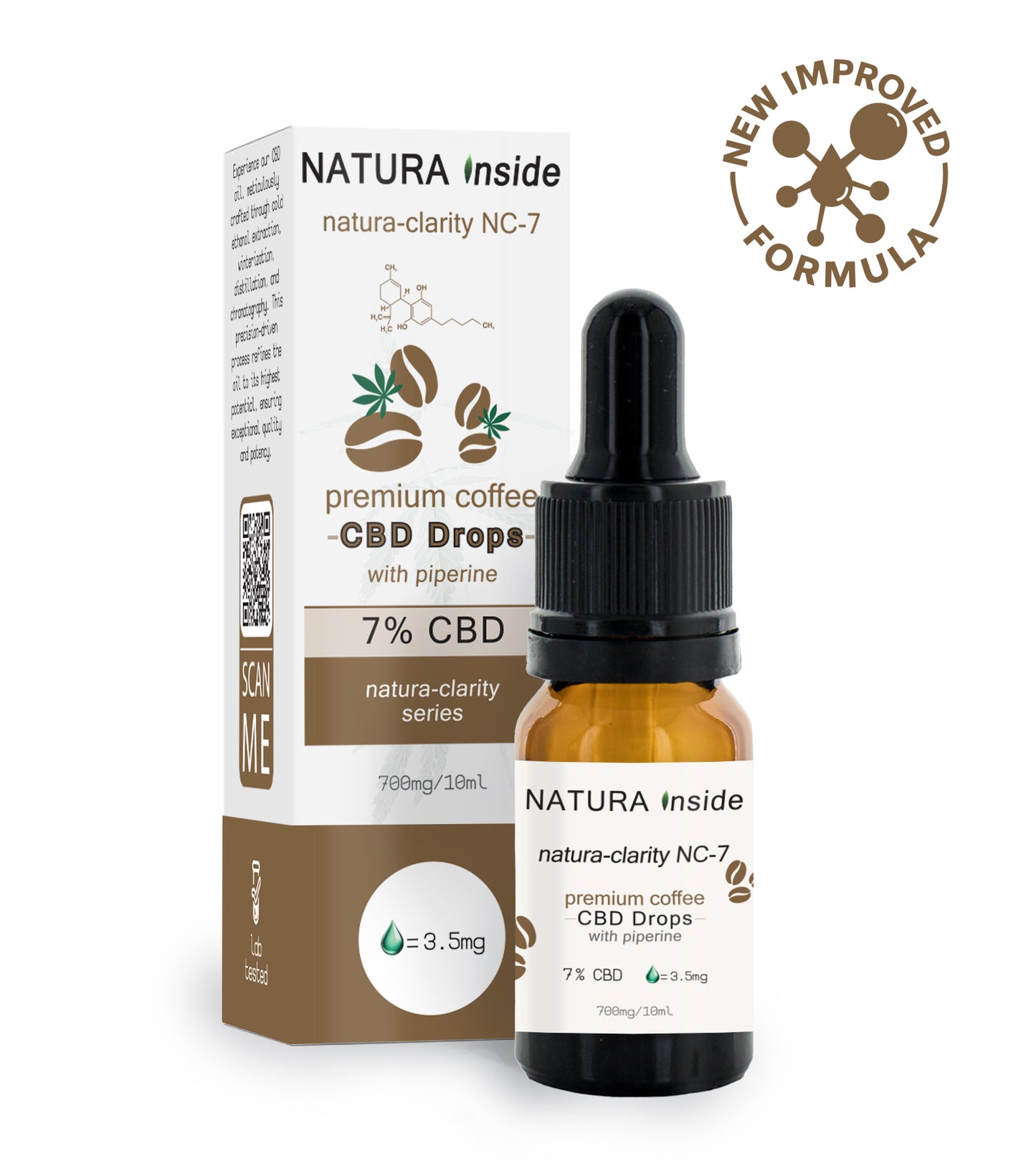Natura Inside
CBD OIL 7% CBD WITH PIPERINE AND COFFEE OIL NATURA-CLARITY SERIES, 10ml
CBD OIL 7% CBD WITH PIPERINE AND COFFEE OIL NATURA-CLARITY SERIES, 10ml
Couldn't load pickup availability
CBD Coffee Drops with Piperine – Natura-Clarity
Natural Synergy for Daily Premium Care
Natura-Clarity is crafted with CBD, cold-pressed Arabica coffee seed oil, and piperine, offering a plant-based formulation that can be easily integrated into daily routines. The blend combines full extract CBD with natural oils, designed to support a balanced lifestyle.
Features
-
CBD Content: 7% (700mg per 10ml)
-
With Piperine: Included to support ingredient bioavailability
-
Cold-Pressed Coffee Seed Oil: Adds a natural touch from Arabica coffee seeds
-
Plant-Based: Made with carefully selected natural ingredients
🧪 How to Use
• Shake well before use
• Apply a small amount 2–3 times daily, preferably every day
• Store in a cool, dark place at room temperature (15–25 °C)
🌿 Key Benefits of CBD Oil
•Helps soothe and calm irritated skin
•Supports natural skin balance and hydration
•Promotes a healthy, radiant-looking complexion
•Rich in antioxidants that help protect against environmental stressors
•Suitable for all skin types, including sensitive skin
Want to learn more about cannabidiol and its properties in oral care and wellness products? Check out this short blog.
🧬 Cannabidiol (CBD) and Scientifically Documented Properties
Cannabidiol (CBD) is a natural phytocannabinoid derived from the Cannabis sativa plant. Unlike tetrahydrocannabinol (THC), CBD is non-psychoactive, making it safe for daily use¹. It interacts with the endocannabinoid system (ECS), which regulates key physiological functions such as anxiety, pain, sleep, and immune balance².
📌 Key Properties Identified in Scientific Literature:
• Anxiety and stress relief: CBD appears to interact with serotonin receptors, contributing to anxiolytic effects³. It has been studied in cases of social anxiety, generalized anxiety disorder, and PTSD.
• Sleep support: Research shows that CBD may improve sleep quality and duration, particularly when sleep disturbances are related to anxiety⁴.
• Anti-inflammatory and analgesic properties: CBD influences CB1, CB2, and TRPV1 receptors, supporting relief from chronic or neuropathic pain and reducing inflammation⁵.
• Physiological balance (homeostasis): By modulating the ECS, CBD may help support general wellbeing and internal balance⁶.
• Antioxidant and immunomodulatory effects: Experimental data suggest CBD may reduce pro-inflammatory cytokines and support immune response⁷.
🦷 CBD in Oral Care Applications
Recent in vitro studies have evaluated CBD for topical use in the oral cavity due to its antimicrobial, anti-inflammatory, and soothing properties⁸:
• Shows antimicrobial activity against common oral pathogens such as Streptococcus mutans and Porphyromonas gingivalis⁸
• Demonstrates effects comparable or superior to chlorhexidine, without side effects like staining⁹
• Well tolerated by oral tissues — no irritation, burning, or discoloration⁸
• Effectively stabilized in carrier oils such as MCT and olive oil, which enhance delivery in oral formulations⁸
Note: This product has been formulated for topical use, in accordance with current European legislation on non-psychoactive industrial hemp products (THC < 0.2%)¹⁰. It is registered in the European CPNP database with Notification Number: CPNP 4619441.
The information presented is based on published scientific literature regarding cannabidiol (CBD) as a compound and does not constitute a health claim for the final product. This product is not intended to diagnose, treat, cure, or prevent any disease.
📚 References
-
World Health Organization. (2018). Cannabidiol (CBD) Critical Review Report.
-
Lowe, H. I. C., Toyang, N. J., & McLaughlin, W. (2021). Medicines, 8(6), 44. https://doi.org/10.3390/medicines8060044
-
Blessing, E. M., et al. (2015). Neurotherapeutics, 12(4), 825–836. https://doi.org/10.1007/s13311-015-0387-1
-
Shannon, S., et al. (2019). The Permanente Journal, 23. https://doi.org/10.7812/TPP/18-041
-
Whiting, P. F., et al. (2015). JAMA, 313(24), 2456–2473. https://doi.org/10.1001/jama.2015.6358
-
Nichols, J. M., & Kaplan, B. L. (2020). Cannabis and Cannabinoid Research, 5(1), 12–31. https://doi.org/10.1089/can.2018.0073
-
Kozela, E., et al. (2011). Journal of Neuroimmune Pharmacology, 6(3), 529–540. https://doi.org/10.1111/j.1476-5381.2011.01379.x
-
Stahl, V., & Vasudevan, K. (2020). Cureus, 12(1), e6809. https://doi.org/10.7759/cureus.6809
-
Iffland, K., & Grotenhermen, F. (2017). Cannabis and Cannabinoid Research, 2(1), 139–154. https://doi.org/10.1089/can.2016.0034
-
Regulation (EU) No 1307/2013 and Directive 2002/46/EC – EU compliance on hemp and novel foods
Share










